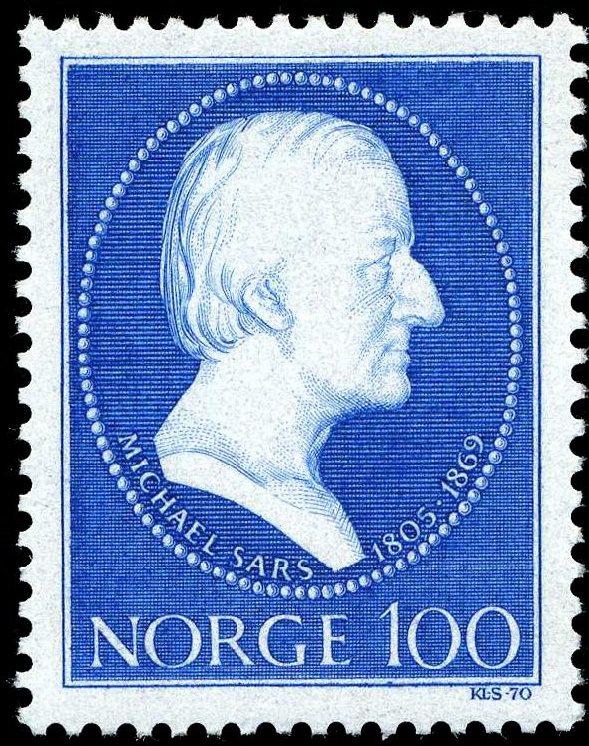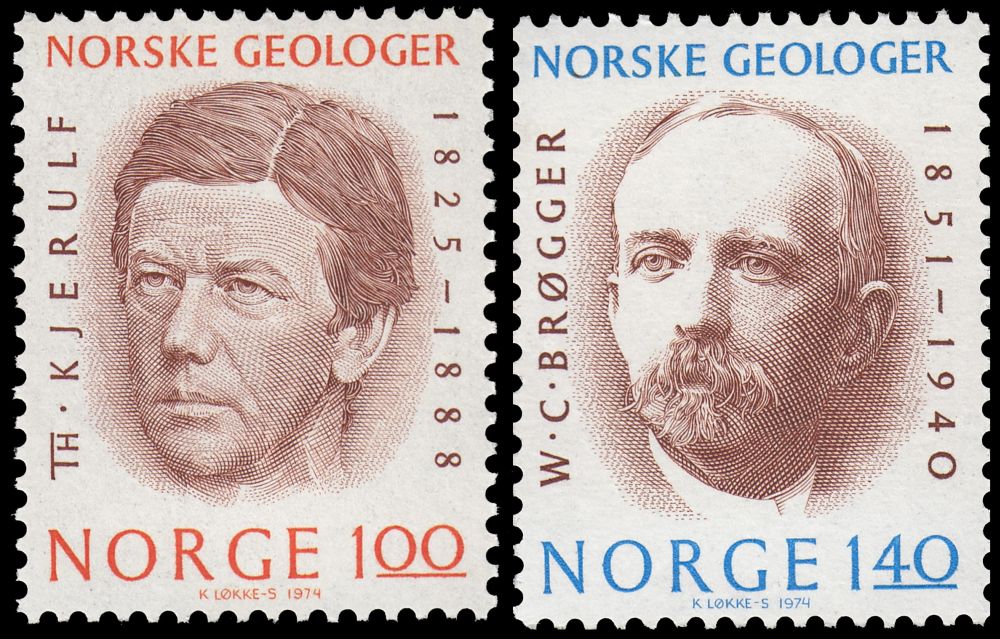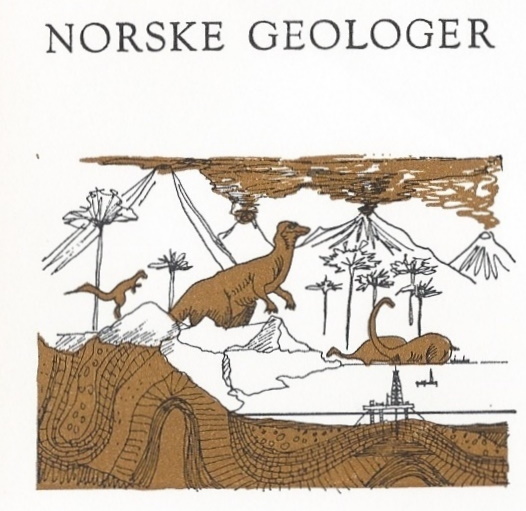the place where Paleontology and Paleoanthropology meets Philately
Norway
Fossils and prehistoric animals on stamps and postmarks of Norway
| << previous country | back to index | next country >> |
Contents:
- Country overview
- Philately of Norway
- Some stamps of Norway to consider
- Commemorative postmarks of Norway related to Paleontology
- References
- Acknowledgements
Norway, officially the Kingdom of Norway, is a sovereign and unitary monarchy whose territory comprises the western portion of the Scandinavian Peninsula plus the island Jan Mayen and the archipelago of Svalbard. The Kingdom of Norway historically included the Faroe Islands, Greenland, and Iceland.
Between 1450 and 1814, Norway was in a union with Denmark. As part of the rearrangement of Europe after the Napoleonic Wars, Norway was given to the Kingdom of Sweden, while Denmark retained the Faroe Islands, Greenland and Iceland.
Norway dissolved the union with Sweden in 1905 (and Iceland gained independence from Denmark in 1918).
Norway has a total area of 385,252 square kilometres and a population of 5.3 million. The country shares a long eastern border with Sweden. Norway is bordered by Finland and Russia to the north-east, and the Skagerrak Strait to the south, with Denmark on the other side.
A constitutional monarchy, Norway divides state power between the Parliament, the Cabinet, and the Supreme Court, as determined by the 1814 Constitution. [R1]
The first postage stamp was issued in 1855 and depicted the Coat of arms of Norway.
Numeral cancellations were used by the Norwegian Post Office to show that the stamps had been used. Numeral cancellations included both a geometric design and a number – with the Norwegian Post discontinuing them after reaching 383.
In 1871, Norway introduced its first stamp with a posthorn design; stamps of this type, with periodic redesigns, have been in use ever since. [R2]
Some stamps of Norway to consider: contributors to Paleontology science
| 15.10.1970 "Zoologists" [A1] | 04.09.1974 "Geologists" [A2] | 16.09.2005 "Norwegian Geology" [A3] |
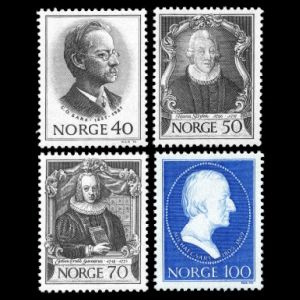 |
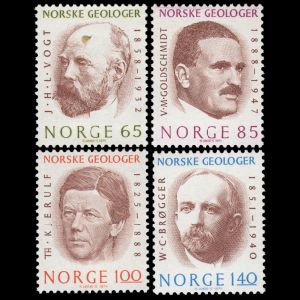 |
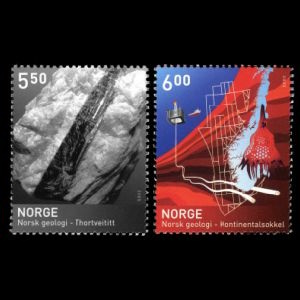 |
Notes:
[A1] Michael Sars (1805 - 1869), shown on the blue stamp, was one of the last great descriptive zoologists who catalogued organisms more or less equally successfully in all major animal groups.
[R4]
[A2] Two geologists shown on these stamps have had significant contribution to Paleontology.
Theodor Kjerulf (1825 – 1888) was a Norwegian geologist and poet.
His contributions to the geology of Norway were numerous and important, specially concerning the southern portion of the country,
the structure and relations of the Archaean and Palaeozoic rocks and the glacial phenomena.
Published "The Silurian Rocks and Fossils of Norway" in 1858.
[R6]
Waldemar Christofer Brøgger (1851 – 1940), who is depicted on stamp with the face value of 140,
was a Norwegian geologist and mineralogist.
His research on Permian igneous rocks (286 to 245 million years ago), include some fossils, of the Oslo
district greatly advanced petrologic theory on the formation of rocks.
[R5]
[A3] The stamp with face value of 5.50 shows the world's first scandium mineral, Thortveitite. It was discovered in Setesdal in 1903 and called after Norwegian mineral exporter Olaus Thortveit (1872-1917).
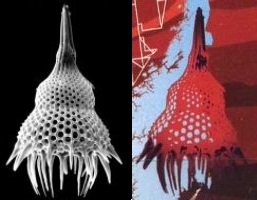
|
| Photo and representation of Lamprocyclas maritalis on stamp of Norway 2005. MiNr.: 1553, Scott: 1449 |
Radiolarians (also radiolaria) are amoeboid protozoa (diameter 0.1-0.2 mm) that
produce intricate mineral skeletons, typically with a central capsule dividing the cell into inner and outer portions,
called endoplasm and ectoplasm.
They are found as zooplankton throughout the ocean, and their skeletal remains cover large portions of the ocean bottom as
radiolarian ooze.
Due to their rapid turn-over of species, they represent an important diagnostic fossil-found from the Cambrian onwards.
Radiolarians and other fossil plankton are very useful index fossils that help geologists and paleontologists
to constrain the age of the rocks hosting the fossils. [R3]
Commemorative postmarks of Norway related to Paleontology: fossils
| 04.10.1985 "Norwegian professional life" [FDC] | ||
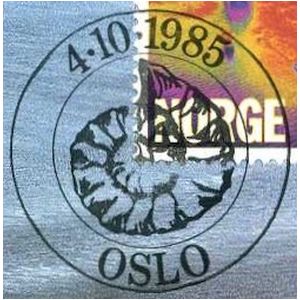 |
|
|
References:
- [R1] Norway: Wikipedia, WikiTravel, FlagCounter.
- [R2] Postal History and Philately of Norway:
Wikipedia,
Links to official website of Postal Authority, online store, stamp catalog and stamps issue plan of Norway are here. - [R3] Radiolarians: Wikipedia, MarienSpecies.org, Radiolaria.org.
- [R4] Michael Sars: Wikipedia,
- [R5] Waldemar Christofer Brøgger: Wikipedia,
- [R6] Theodor Kjerulf: Wikipedia,
Acknowledgements:
Many thanks to Dr. Peter Voice from Department of Geological and Environmental Sciences, Western Michigan University, for the draft page review and his valuable comments.
| << previous country | back to index | next country >> |
